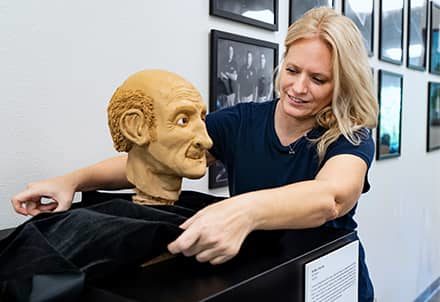Thrive
Cold case files: USF forensic anthropologist seeks the public’s help

With the public’s help, an exhibition hopes to identify 20 people who remain nameless decades after their deaths, provide closure to their families and potentially solve their murders.
The Art of Forensics is now open at the Sulphur Springs Museum & Heritage Center in Tampa, and will run through Nov. 1. The exhibition’s goal is to provide a clearer picture of cold case homicide victims in the hopes of sparking the public’s memory. The exhibit includes clay sculptures, digital composites, photographs and drawings of 20 John and Jane Does. The display was created by University of South Florida forensic anthropologist Erin Kimmerle, along with USF graduate student and Tampa Bay Times journalist John Pendygraft.
“We’re hoping that someone out there knows who these people are and that they recognize someone,” said Kimmerle, Executive Director of the Florida Institute for Forensic Anthropology and Applied Science. “Ultimately, the goal is to create a likeness of a face because what you have to work with is skeletal remains, and a little bit of whatever material evidence is found.”
The Art of Forensics has been a success since its inception in 2015, helping to solve two dozen cold case homicides. Kimmerle presents the exhibit annually and tries to find new and innovative ways to shed light on these unknown victims. She said the number of open homicides and missing person cases continues to rise exponentially because new cases take precedent, and because there is a shortage of people to work on them.
“Even though we solve cold cases all the time, there’s constantly more added to that list,” said Kimmerle. “So, it just keeps growing.”
Three of the nameless bodies were exhumed from Rest Haven Memorial Park in Tampa last year, and half of the cases featured in the exhibit are from Hillsborough County. The remainder comes from other parts of Central Florida, North Carolina and Pennsylvania.
Kimmerle said skeletal remains help identify a person’s age, sex and ancestry, and they are not only trying to recreate a person’s likeness, but they are also trying to tell their story. The cases they have solved are not only ones featured in her exhibit, but many are from bringing in families of missing persons who do not have DNA on file or whose case “fell through the cracks for whatever reason.”
“Even if one of these 20 individuals is not who they are looking for, we have thousands more,” she said. “We’ve seen cases get solved like that over and over again.”
Kimmerle said there are about 1,000 unidentified individuals in Florida and about 40,000 nationwide. She adds that the majority of those are homicides. Some of the cases go back to the 1960s, although most are from the last 30 years. Kimmerle treats these old cases like they are fresh, starting from the beginning and making sure everything meets today’s scientific standards.
The team conducts DNA testing and chemical isotope testing and works with law enforcement and the medical examiner’s office to make sure everything is up to current standards on that side as well. The clay facial reconstructions seen in the exhibit are the final step in the process.

Kimmerle said she would love to bring The Art of Forensics to St. Petersburg, but it has been difficult to find a gallery or public space to house the exhibition. Her team has worked extensively with the St. Petersburg Police Department over the years, and one of the oldest cold cases in the exhibit originated from St. Pete.
New to this year’s exhibit is Pendygraft’s photography series. He sought to provide an intimate look into the lives of those who work to solve unidentified and missing person cases and cold case homicides. Pendygraft said the public perception of cold cases is very “Hollywood,” and the point of his story was to show the gritty reality.
“The cases are cool, and everything’s solved before the credits roll, and the budgets are huge, and the labs are amazing,” he explained. “The truth of it is, cold cases are often the most vulnerable people in society, who were vulnerable during their life, and they’re more vulnerable after they’re dead.”
Pendygraft called the work that goes into solving these cases thankless, often underfunded, and heart-wrenching.
“The common denominator I came away with after seeing and photographing these people is a very deep commitment to social justice and to finding closure for these families,” he said. “This kind of work is truly a call to public service.”
Kimmerle wants people to know that these cases are only solved with the public’s help. She said there are thousands of cases sitting on shelves that have not been looked at in decades, “and if we forget about them, then they’re going to be lost to time.”







